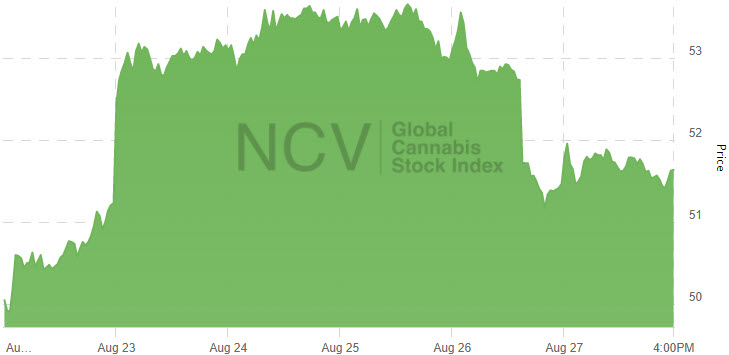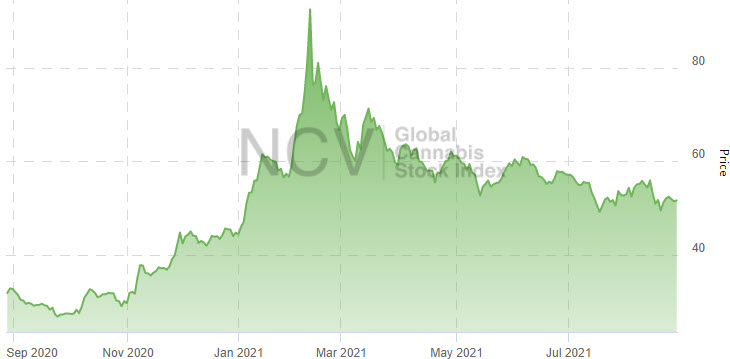Navigate the fast-moving cannabis sector with 420 Investor, a premium service that sends real-time alerts and explanations of the news below and much more.
Summary
- Stocks advanced in a quiet week with respect to news.
- Health Canada added 5 new licenses, leaving the total now at 754.
- 420 Investor model portfolios have gained 25.3-57.5% year-to-date, while the Global Cannabis Stock Index has gained 16.3%.
Review
The stocks advanced modestly on light news flow.
Health Canada added 5 licenses, leaving the total at 754 including 7 that are expired, revoked or suspended.
During the week, I shared these insights with subscribers at 420 Investor:
- Model Portfolio Composition 08/20/21
- Cannabis Sub-Sector Review – 08/20/21
- Previews for Harborside, Planet 13 and TILT Holdings Financial Reports
- Ayr Is No Longer Too Thin
Here are some of this week’s highlights for 420 Investor Focus List names:
- ACB made its initial shipment to France from its Denmark facility
- CRON issued 1.5 million shares to Gingko upon achievement of a milestone related to the production of CBDA through biosynthesis
- CURLF opened its third NJ dispensary
- FFLWF will pay $8.5 million to buy PotGuide, extending its digital strategy
- GNLN shareholders approved the merger with KushCo Holdings
- GRAMF introduced a line of wellness products
- GRWG acquired a store in Washington and one in Los Angeles County
- KSHB shareholders approved the merger with Greenlane
- OGI launched a value-priced gummies line under its SHRED brand, SHRED’ems.
- PLNHF tripled revenue in Q2 to $32.8 million, with adjusted EBITDA of $7.2 million
- SHWZ will be acquiring an indoor grow in Colorado for $6.7 million
- TCNNF opened its 101st dispensary overall, adding three dispensaries in Florida, where it now operates 91.
- TLLTF signed a partnership with the Shinnecock Nation to finance and manage its vertically integrated cannabis operations on Long Island. Q2 revenue grew 33% to $48.5 million, with adjusted EBITDA of $6.5 million.
- VRNOF opened its 37th Florida dispensary
The Global Cannabis Stock Index recovered some of last week’s big losses, increasing 0.9% to 51.64:
 The index, which lost 34.1% in 2019 and lost 54.9% in 2018 after gaining 91.8% in 2017 and 88.8% in 2016, was up 5.2% in 2020. It has gained 16.3% in 2021 thus far. It currently includes 44 stocks and ended 2020 at 44.39:
The index, which lost 34.1% in 2019 and lost 54.9% in 2018 after gaining 91.8% in 2017 and 88.8% in 2016, was up 5.2% in 2020. It has gained 16.3% in 2021 thus far. It currently includes 44 stocks and ended 2020 at 44.39:
 Model Portfolios
Model Portfolios
420 Investor offers three model portfolios for subscribers, including two that are long-term focused and fully invested with a goal of beating the Global Cannabis Stock Index, 420 Opportunity and 420 Quality. 420 Opportunity ended the week valued at $142,928, up 3.6%. The model portfolio, up 35.6% in 2021, gained 35.6% in 2020 and has increased 185.9% since April 2014. 420 Quality ended the week at $202,290, up 3.9% for the week, and is now up 25.3% in 2021 after gaining 42.8% in 2020. The model was launched in March 2017 targeting long-term investors seeking to invest in leading cannabis stocks with low portfolio turnover and has gained 304.6% since inception compared to the 36.1% decline in the index. Flying High, which is focused on swing trades, ended the week valued at $397,553, up 1.5%. The model portfolio gained 52.7% in 2020 and is up 57.5% in 2021, and the return since inception in late 2013 has been 3876%.
Outlook
After a strong rally to begin 2019, the cannabis sector experienced a sharp decline over the next year to unprecedented levels due to several negative developments, including the CannTrust fraud, the surprise termination of Bruce Linton as CEO of Canopy Growth, a disappointing roll-out of legalization in Canada, regulatory confusion in the U.S. regarding CBD and a slow roll-out of legalization in California, the vaping crisis and then financial turmoil and market disruptions due to the COVID-19 pandemic. The sector saw capital available to fund expansion dry up, a situation that continues to leave companies operating with negative cash flow severely challenged, as the availability is limited to stronger operators.
Cannabis stocks overreacted and put in a bottom in March 2020, and benefited from a perception that the industry offers strong growth prospects, something that wasn’t clear then. A big change was that the pandemic caused many regulators to permit previously prohibited types of retail activities, like curbside pickup and delivery. The legal market rapidly capitalized on becoming even more convenient than the illicit market, with the ability to order online. States and municipalities moved to broaden adult-use and medical access. Access to capital improved dramatically, and the leading companies began generating large and rapidly growing revenue and profits.
The strong finish to 2020 continued into 2021 after the Democrats took control of the Senate in early January, but the stocks got way ahead of themselves and have been consolidating since then. In addition to concerns that federal legalization will take a longer time than many have expected, there have been some tough comparisons to year-ago sales levels. Additionally, while several institutions embraced the sector early in the year, there has been a lull in additional interest.
There are several potential catalysts ahead, including the FDA (or Congress) providing clarity on CBD regulation, progress in the Canadian legalization that commenced in October 2018 and that is beginning to include a broader set of products and the continued growth in German and Israeli MMJ and other international markets that have been slow to develop. The adult-use implementations in California and Massachusetts for adult-use were slow to roll out but are beginning to show great improvement. Michigan and Illinois legalized for adult-use at the end of 2019, and these markets are showing strong growth that could encourage other states to legalize. Voters in Arizona, Montana, South Dakota and New Jersey all approved adult-use legalization in November, and Connecticut, New Mexico, New York and Virginia have enacted legalization through the legislative process in 2021.
The big themes ahead are likely to be continued cross-industry investment into the sector and more consolidation in Canada and in the U.S., potential federal regulatory reform (SAFE Banking Act and other more comprehensive legislation, which could eliminate 280E taxation and enable trading on higher exchanges for MSOs as well as the broad usage of credit cards for cannabis purchases), steps to enable cannabis research, the roll out of MMJ in Germany, Mexico and in Australia as well as continued advances in South America and potential adult-use legalization in Israel and Mexico, new legal cannabis implementations in AZ, MT, NJ and SD, and MMJ implementations in AL, WV and VA, possible legalization via the legislatures in DE, FL, MD, MN, NH, PA and RI and implementation of the CT, NM, NY and VT commercial programs in 2022 and VA in 2024.
After bottoming in March 2020, the cannabis sector has been in a new bull market. Many companies are generating substantial revenue and some even a profit, and liquidity is much better. The sector has transitioned away from many legacy penny stocks that had never proven that they had viable businesses towards better capitalized companies, many of which have strong management teams and substantial businesses. The investor base has also transitioned, becoming increasingly more institutional.
